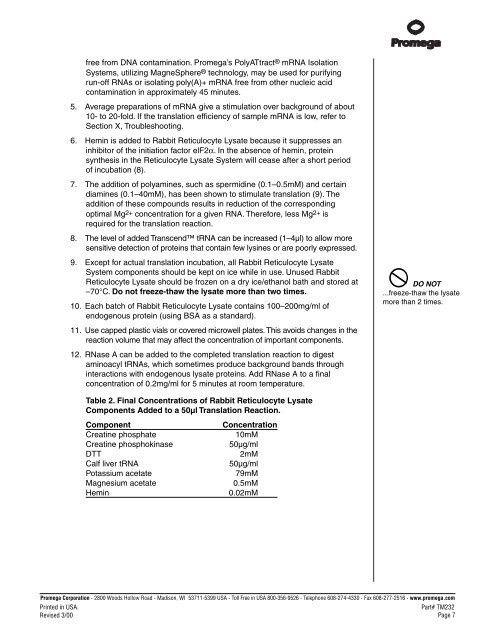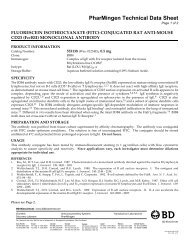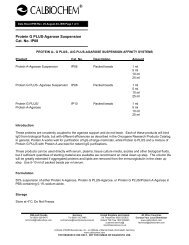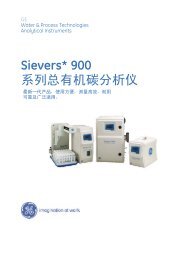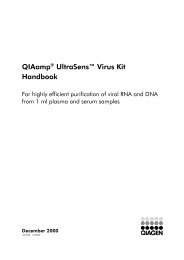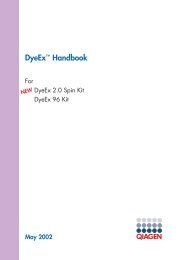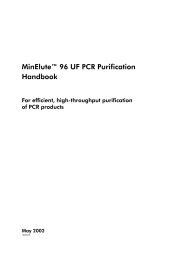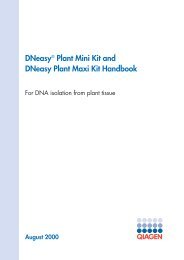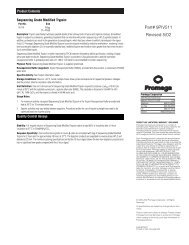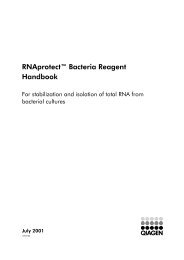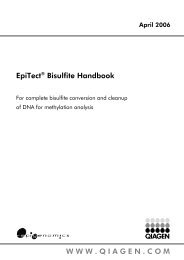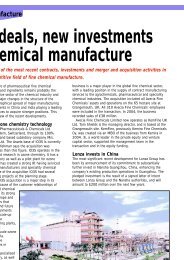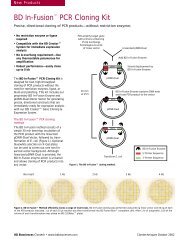Rabbit Reticulocyte Lysate System Technical Manual, TM232
Rabbit Reticulocyte Lysate System Technical Manual, TM232
Rabbit Reticulocyte Lysate System Technical Manual, TM232
Create successful ePaper yourself
Turn your PDF publications into a flip-book with our unique Google optimized e-Paper software.
free from DNA contamination. Promega’s PolyATtract ® mRNA Isolation<br />
<strong>System</strong>s, utilizing MagneSphere® technology, may be used for purifying<br />
run-off RNAs or isolating poly(A)+ mRNA free from other nucleic acid<br />
contamination in approximately 45 minutes.<br />
5. Average preparations of mRNA give a stimulation over background of about<br />
10- to 20-fold. If the translation efficiency of sample mRNA is low, refer to<br />
Section X, Troubleshooting.<br />
6. Hemin is added to <strong>Rabbit</strong> <strong>Reticulocyte</strong> <strong>Lysate</strong> because it suppresses an<br />
inhibitor of the initiation factor elF2α. In the absence of hemin, protein<br />
synthesis in the <strong>Reticulocyte</strong> <strong>Lysate</strong> <strong>System</strong> will cease after a short period<br />
of incubation (8).<br />
7. The addition of polyamines, such as spermidine (0.1–0.5mM) and certain<br />
diamines (0.1–40mM), has been shown to stimulate translation (9). The<br />
addition of these compounds results in reduction of the corresponding<br />
optimal Mg2+ concentration for a given RNA. Therefore, less Mg2+ is<br />
required for the translation reaction.<br />
8. The level of added Transcend tRNA can be increased (1–4µl) to allow more<br />
sensitive detection of proteins that contain few lysines or are poorly expressed.<br />
9. Except for actual translation incubation, all <strong>Rabbit</strong> <strong>Reticulocyte</strong> <strong>Lysate</strong><br />
<strong>System</strong> components should be kept on ice while in use. Unused <strong>Rabbit</strong><br />
<strong>Reticulocyte</strong> <strong>Lysate</strong> should be frozen on a dry ice/ethanol bath and stored at<br />
–70°C. Do not freeze-thaw the lysate more than two times.<br />
10. Each batch of <strong>Rabbit</strong> <strong>Reticulocyte</strong> <strong>Lysate</strong> contains 100–200mg/ml of<br />
endogenous protein (using BSA as a standard).<br />
11. Use capped plastic vials or covered microwell plates. This avoids changes in the<br />
reaction volume that may affect the concentration of important components.<br />
12. RNase A can be added to the completed translation reaction to digest<br />
aminoacyl tRNAs, which sometimes produce background bands through<br />
interactions with endogenous lysate proteins. Add RNase A to a final<br />
concentration of 0.2mg/ml for 5 minutes at room temperature.<br />
Table 2. Final Concentrations of <strong>Rabbit</strong> <strong>Reticulocyte</strong> <strong>Lysate</strong><br />
Components Added to a 50µl Translation Reaction.<br />
Component Concentration<br />
Creatine phosphate 10mM<br />
Creatine phosphokinase 50µg/ml<br />
DTT 2mM<br />
Calf liver tRNA 50µg/ml<br />
Potassium acetate 79mM<br />
Magnesium acetate 0.5mM<br />
Hemin 0.02mM<br />
DO NOT<br />
...freeze-thaw the lysate<br />
more than 2 times.<br />
Promega Corporation · 2800 Woods Hollow Road · Madison, WI 53711-5399 USA · Toll Free in USA 800-356-9526 · Telephone 608-274-4330 · Fax 608-277-2516 · www.promega.com<br />
Printed in USA. Part# <strong>TM232</strong><br />
Revised 3/00 Page 7


